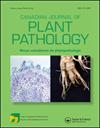Efficacy of fumigants and biofumigants for the control of replant disease of American ginseng (Panax quinquefolius)
IF 1.5
4区 农林科学
Q3 PLANT SCIENCES
引用次数: 2
Abstract
Abstract Ginseng replant disease (GRD) prevents the successful production of a second ginseng crop on the same ground even decades after the first crop. A study was initiated in 2013 to compare the efficacy of fumigants and biofumigants at two sites: (1) a replant garden planted to ginseng one year after a crop had been harvested, and (2) a non-replant site in which ginseng had never been grown. Treatments included chloropicrin and metam-sodium fumigants covered in totally impermeable film (TIF), un-tarped metam-sodium, modified mustard seed meal (MSM), and a mustard-capsaicin product (MC), and both a tarped and un-tarped control. Treatments were applied in June and July 2013 and ginseng seeded in August 2013. Plant stand was assessed monthly throughout the trial beginning after germination in spring 2014, and yield and quality were assessed at harvest in 2016 (replant site) and 2017 (non-replant site). At the replant site, plant stand declined rapidly in the un-tarped control, MSM, and MC treatments in the seedling year with no roots surviving to harvest. Although all plots had some disease at harvest, chloropicrin, metam-sodium, and the tarped control significantly improved yield. Disease pressures were low at the non-replant site and there were no consistent differences among treatments. Using Koch’s postulates, the cause of the rot in the replanted plot was confirmed to be Ilyonectria mors-panacis, although other factors are likely involved in the disease. Plant parasitic nematodes were not present in the replant site suggesting they may not be important factors in replant disease severity.熏蒸剂和生物熏蒸剂防治西洋参再植病的效果研究
摘要人参复种病(GRD)阻碍了在同一土地上成功生产第二批人参,甚至在第一批人参种植几十年后。2013年启动了一项研究,以比较两个地点的熏蒸剂和生物熏蒸剂的效果:(1)在作物收获一年后种植人参的重新种植园,以及(2)从未种植过人参的非重新种植地。处理包括覆盖在完全不可渗透膜(TIF)中的氯化苦和超敏钠熏蒸剂、未防水的超敏钠、改性芥末籽粉(MSM)和芥末辣椒素产品(MC),以及防水和未防水的对照。治疗于2013年6月和7月进行,人参于2013年8月播种。从2014年春季发芽后开始,在整个试验过程中每月对林分进行评估,并在2016年(重新种植地)和2017年(非重新种植点)收获时对产量和质量进行评估。在重新种植的地方,未覆盖对照、MSM和MC处理的植株在幼苗年的林分迅速下降,没有根系存活下来收割。尽管所有地块在收获时都有一些病害,但氯化苦、异美那钠和防水剂对照显著提高了产量。非再植部位的疾病压力较低,治疗之间没有一致的差异。根据Koch的假设,重新种植的地块中腐烂的原因被证实是Ilyonectria mors panacis,尽管其他因素可能与该疾病有关。植物寄生线虫不存在于再植部位,这表明它们可能不是影响再植疾病严重程度的重要因素。
本文章由计算机程序翻译,如有差异,请以英文原文为准。
求助全文
约1分钟内获得全文
求助全文
来源期刊
CiteScore
4.50
自引率
5.00%
发文量
56
审稿时长
6-12 weeks
期刊介绍:
Canadian Journal of Plant Pathology is an international journal which publishes the results of scientific research and other information relevant to the discipline of plant pathology as review papers, research articles, notes and disease reports. Papers may be submitted in English or French and are subject to peer review. Research articles and notes include original research that contributes to the science of plant pathology or to the practice of plant pathology, including the diagnosis, estimation, prevention, and control of plant diseases. Notes are generally shorter in length and include more concise research results. Disease reports are brief, previously unpublished accounts of diseases occurring on a new host or geographic region. Review papers include mini-reviews, descriptions of emerging technologies, and full reviews on a topic of interest to readers, including symposium papers. These papers will be highlighted in each issue of the journal and require prior discussion with the Editor-in-Chief prior to submission.

 求助内容:
求助内容: 应助结果提醒方式:
应助结果提醒方式:


